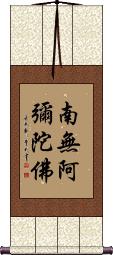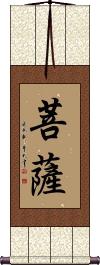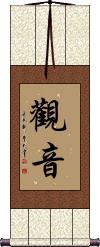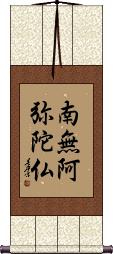Many custom options...
And formats...

Namo Amitabha in Chinese / Japanese...
Buy a Namo Amitabha calligraphy wall scroll here!
Personalize your custom “Namo Amitabha” project by clicking the button next to your favorite “Namo Amitabha” title below...
Namo Amitabha Buddha
南無阿彌陀佛 is how to express “The Compassionate Amitabha Buddha” (especially for the Pure Land Buddhist Sect).
Some will translate as “Homage to Amitâbha Buddha” or “I seek refuge in the Amitâbha Buddha.”
This is valid in Chinese characters, Japanese Kanji, and old Korean Hanja.
Sometimes modern Japanese use a different version of the 4th and last Kanji, but the version shown here is the most universal.
This is used to pay homage to Amitabha Buddha.
See Also: Bodhisattva | Buddhism | Nirvana
Bodhisattva
菩薩 is the title of a Buddhist deity that exists to help you reach enlightenment.
In Buddhist beliefs, a bodhisattva (bodhisatta) is dedicated to helping us achieve enlightenment. Bodhisattva means enlightenment truth which is bodhi sattva in Sanskrit.
This term is sometimes used to refer to a kindhearted person, one who will sacrifice himself/herself for others and lacks ego or desire but is instead devoted to the good and well-being of others.
See Also: Buddha
Goddess of Mercy and Compassion
觀音/観音 is the Buddhist deity known as the Goddess of Mercy or Bodhisattva of Compassion.
In Chinese, the proper name of this being is Guan Yin. There is some debate as to whether Guan Yin is female. The argument comes from some scripture that suggests Buddhist deities take on the male form. Others say that Guan Yin has no sex. And still, others are okay with the female representation of Guan Yin.
This bodhisattva is also known or Romanized in the following ways:
Mandarin Chinese: Guan Yin, Kuan Yin, Kwan Yin.
Japanese: Kannon, Kwannon.
Sanskrit: Bodhisattva Avalokitesvara.
Korean: Gwan-eum.
Vietnamese: Quan Âm.
Thai: Kuan Eim.
English: Bodhisattva of Mercy and Salvation, Goddess of Compassion, Buddha of Mercy, et al.
Note: The first character has a slight variation in Japanese. If your audience is specifically Japanese, you may want to select that version.
See Also: Buddhism | Goddess | Bodhisattva
Namu Amida Butsu
南無阿弥陀仏 is the modern Japanese version of “Namu Amida Butsu” or “The Compassionate Amitabha Buddha.”
Some will translate this as “I sincerely believe in Amitabha; Lord have mercy on me.”
This phrase especially applies to Japanese Pure Land Buddhists.
There is a universal version using ancient characters (with more strokes) for the 4th and last characters. That version is also used in Chinese, Korean, and occasionally Vietnamese.
This is used to pay homage to Amitabha Buddha.
See Also: Bodhisattva | Buddhism | Nirvana
Not the results for namo amitabha that you were looking for?
Below are some entries from our dictionary that may match your namo amitabha search...
| Characters If shown, 2nd row is Simp. Chinese |
Pronunciation Romanization |
Simple Dictionary Definition |
南無阿彌陀佛 南无阿弥陀佛 see styles |
nán wú ā mí tuó fó nan2 wu2 a1 mi2 tuo2 fo2 nan wu a mi t`o fo nan wu a mi to fo namo amida butsu |
More info & calligraphy: Namo Amitabha Buddha |
下品 see styles |
xià pǐn xia4 pin3 hsia p`in hsia pin shimoshina しもしな |
(noun or adjectival noun) vulgar; indecent; coarse; crude; (place-name) Shimoshina The three lowest of the nine classes born in the Amitābha Pure Land, v. 無量壽經. These three lowest grades are (1) 下品上生 The highest of the three lowest classes who enter the Pure Land of Amitābha, i.e. those who have committed all sins except dishonouring the sūtras. If at the end of life the sinner clasps hands and says "Namo Amitābha", such a one will be born in His precious lake. (2) 下品中生 The middle class consists of those who have broken all the commandments, even stolen from monks and abused the law. If at death such a one hears of the great power of Amitābha, and assents with but a thought, he will be received into paradise. (3) 下品下生 The lowest class, because of their sins, should have fallen into the lowest gati, but by invoking the name of Amitābha, they can escape countless ages of reincarnation and suffering and on dying will behold a lotus flower like the sun, and, by the response of a single thought, will enter the Pure Land of Amitābha. |
六字 see styles |
liù zì liu4 zi4 liu tzu mutsuji むつじ |
(given name) Mutsuji The six words or syllables, 南無阿彌陀佛 Namo Amitābha. |
十念 see styles |
shí niàn shi2 nian4 shih nien juunen / junen じゅうねん |
(surname) Jūnen The ten repetitions of an invocation, e.g. namo Amitābha. |
南無 南无 see styles |
nā mó na1 mo2 na mo namu なむ |
Buddhist salutation or expression of faith (loanword from Sanskrit); Taiwan pr. [na2 mo2] (conj,int) {Buddh} amen; hail; (surname) Namu namaḥ; Pali: namo; to submit oneself to, from to bend, bow to, make obeisance, pay homage to; an expression of submission to command, complete commitment, reverence, devotion, trust for salvation, etc. Also written 南牟; 南謨; 南忙; 那謨 (or 那模 or 那麻); 納莫 (or 納慕); 娜母; 曩莫 (or 曩謨); 捺麻(or捺謨), etc. It is used constantly in liturgy, incantations, etc., especially as in namaḥ Amitābha, which is the formula of faith of the Pure-land sect, representing the believing heart of all beings and Amitābha's power and will to save; repeated in the hour of death it opens the entrance to the Pure Land. |
南無佛 南无佛 see styles |
nán wú fó nan2 wu2 fo2 nan wu fo namu butsu |
南無三寳 I devote myself entirely to the Buddha, or triratna, or Amitābha, etc. |
The following table may be helpful for those studying Chinese or Japanese...
| Title | Characters | Romaji (Romanized Japanese) | Various forms of Romanized Chinese | |
| Namo Amitabha Buddha | 南無阿彌陀佛 南无阿弥陀佛 | na mu a mi da butsu namuamidabutsu | nā mó ē mí tuó fó na1 mo2 e1 mi2 tuo2 fo2 na mo e mi tuo fo namoemituofo | na mo o mi t`o fo namoomitofo na mo o mi to fo |
| Bodhisattva | 菩薩 菩萨 | bosatsu | pú sà / pu2 sa4 / pu sa / pusa | p`u sa / pusa / pu sa |
| Goddess of Mercy and Compassion | 觀音 / 観音 观音 | kan non / kannon | guān yīn / guan1 yin1 / guan yin / guanyin | kuan yin / kuanyin |
| Namu Amida Butsu | 南無阿弥陀仏 | namu amida butsu namuamidabutsu | ||
| In some entries above you will see that characters have different versions above and below a line. In these cases, the characters above the line are Traditional Chinese, while the ones below are Simplified Chinese. | ||||
Successful Chinese Character and Japanese Kanji calligraphy searches within the last few hours...







